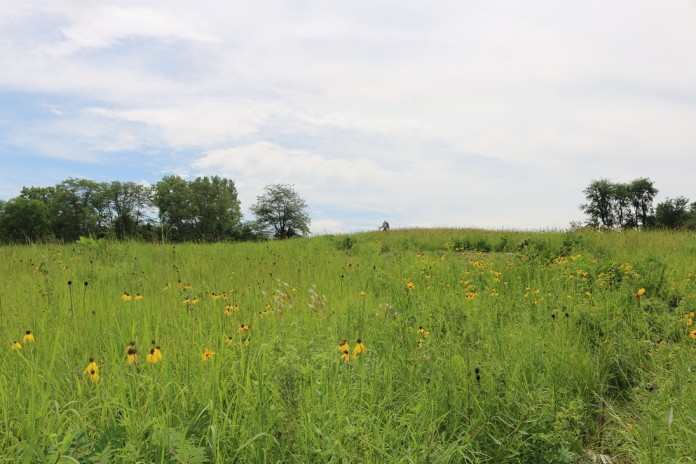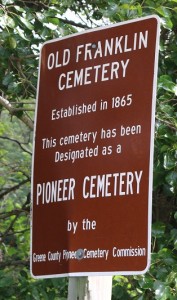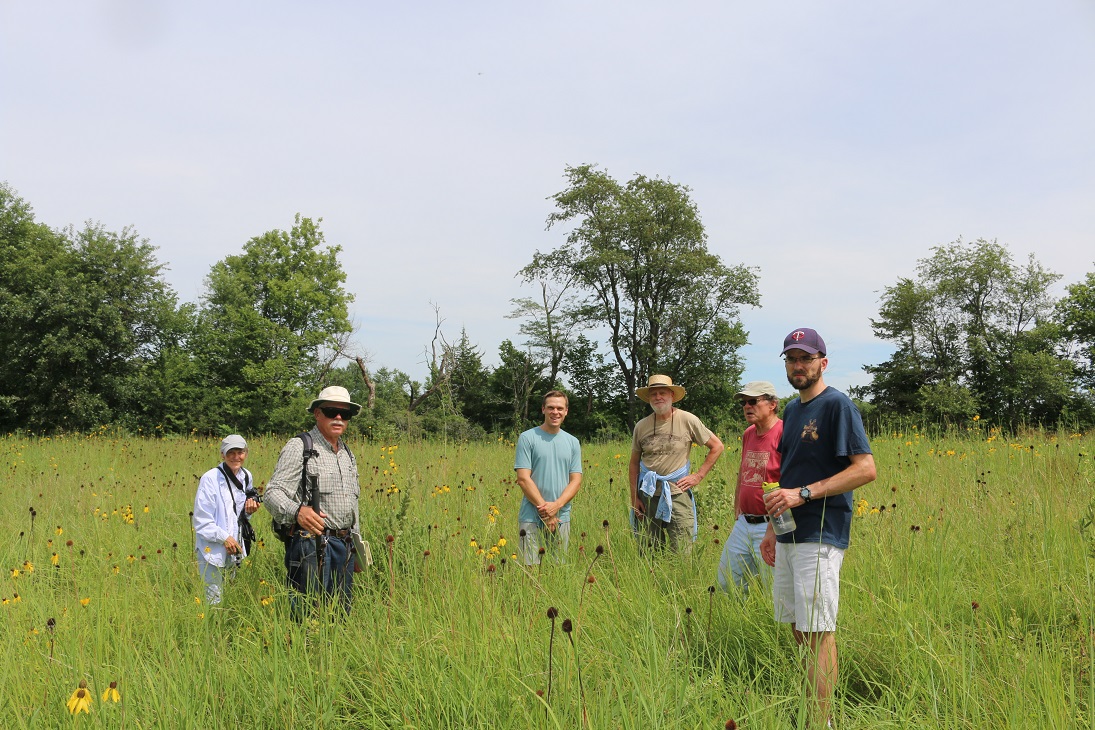
Last Saturday I stood in the midst of a virgin prairie remnant in Greene County with nine other people interested in prairie soil and the life it supports.
It is a four-acre, north-facing hill slope surrounded by trees on three sides and a pasture on the south edge. It is located on County Road E57 between Cooper and Rippey, just a quarter mile west of the Raccoon River.

The Franklin Pioneer Cemetery sign marks the entrance. Be prepared to walk a half-mile if the cable is locked. Follow the lane. Franklin Pioneer cemetery is across the pasture a little ways.
Four of us were amateur students of the prairie ecosystem. Eileen Miller from Lake City was there to help us identify prairie insects of all types. Lloyd Crim, the walk leader, not only knows prairie plants but also is an expert on spiders.
Other prairie walkers included Harlan Ratcliff, an amateur butterfly enthusiast, and a gentleman researcher from Iowa State University specializing in red admiral and monarch butterflies. Ty Smedes, one of the best nature photographers in Iowa, was there as was Jim Caufield from ThePerryNews.com.
Greene County bought the ground from a local farmer. Greene County Conservation Director Dan Towers is maintaining its quality by burning, mowing sumac and holding back the trees.
It is called Tipton Prairie because of neighbors by that name. The plant life is very diverse. It is hard to find a non-native plant among the flowers and grasses on this landscape. It is highly drained gravel and sand soil at the top of the hill, with wet, heavy, rich soil at the bottom.
The types of plants at the top (purple cone flowers and prairie clover) were very different from those in the lower ground (cup plant, culvers root).
The last time members of the Raccoon River Watershed Association visited Tipton Prairie was late June. Dozens of butterfly milkweed were in bloom. Great spangled fritillaries and monarchs on the red-orange flowers made for some great photos.
On this outing the blazing star was in bloom. Dozens of 12-inch lavender flower spikes were attracting the monarchs, red admirals and native bees. One of the interesting things about prairie is the variety of insects and birds that are drawn in.
Most of our garden flowers are not native, but these native prairie flowers are the ones our insects and birds evolved with. They need one another. They form a community of life that wants to come together.
This assemblage of grasses, flowers, insects, birds and soil organisms have been in this location starting about seven thousand years ago. There was a period of desert-like heat and dry weather for thousands of years in Iowa. Fire and drought selected for western dry prairie plants.
A few thousand years ago, cooler weather and rain resulted in a shift in prairie plant species, and deciduous trees began to spread along the river valleys. Another hot, dry period ensued, followed by the temperate climate that our European ancestors and their descendants have enjoyed.
Some very dry-adapted plants remain on the dry soil in this unique remnant. The dotted blazing star found here might be the eastern most example found thus far by prairie experts.
Native Americans walked up and down the Raccoon River Valley since the glacial ice receded from the area about 15,000 years ago. They hunted mastodon, giant buffalo and giant sloth and were hassled by saber-toothed tigers.
The area was covered with white pines, balsam and birches for thousands of years before the temperature rose enough to allow the oaks, walnuts, hickories and other trees to take over. And then came the dry years, the fires and the prairie.
The humans who were here looked a bit Asian since that is where they came from. They thinned out during the dry times but returned and multiplied when conditions became more temperate.
When the Europeans arrived in large numbers in the middle of the 1800s, most of Iowa was prairie, including all the high ground around Tipton and the rest of Raccoon River watershed. There were cottonwoods, willows and silver maples on the flood planes, walnuts and hackberries on the terraces and oaks and hickories on the slopes, forming what is locally called the savannah.
The first settler in Greene County build a log cabin up the river from Tipton Prairie at a place called Squirrel Hollow. There is a nice primitive park there now.
I have been trying to find someone to study the soil at Tipton. What is in that virgin soil? We can see and identify the 100 plants that grow out of that soil. We are listing the insects that come out of the soil and nearby water in order to take advantage of the nectar and the leaf food.
Of course, the spiders, mantises and dragonflies come to feast on the other insects, and the towhee and other birds feed on the seeds and insects. Each of the 300 species of birds that visit Tipton Prairie and the river nearby have their own niche for nesting and their favorite foods, including seeds, insects, reptiles, mammals and other birds.
The bald eagles are back and at the top of the bird food chain, and the vultures clean up the messes.
So, what is in that soil? How does it work? Nobody knows. It seems to me that the agriculture folks at ISU are generally not interested. They are all about chemicals, GMOs, corn varieties, insecticides, herbicides and the like.
It is a wonder that hundreds of birds, thousands of insects, one hundred native plants and some reptiles and mammals still are part of the four-acre ecosystem. Just a few yards from Tipton Prairie is a cornfield dominated by one species of plant, with almost no insects or birds visiting its rows. It is another kind of desert, a man-made, artificial, chemically created desert. You would not know how much of a desert it is if you have not visited a prairie.
I am trying to reconstruct a prairie on 20 acres downstream from Tipton. It has 40 species of plants, with some of the insects and birds that belong there. I was recently studying the butterflies, including monarchs, red admirals, giant swallowtails, red-spotted purple, sulfurs and commas. Dragonflies are also numerous, particularly twelve spots, widow skimmers, amber wings and green darners.
These are pieces of the Iowa ecosystem that I am trying to keep. I was very disappointed while on RAGBRAI to see so few flowers in the ditches east of Storm Lake. I saw only two monarchs in two days of riding to Fort Dodge. In contrast, I saw nine monarchs Saturday on my short drive across my 20-acre prairie.
Aldo Leopold told us not to throw away the pieces of our ecosystem even if we do not know what they are for. We all need a “land ethic” for esthetic reasons but also practical reasons. We need to keep our ecosystem working. We need pollinators and soil organisms for our food supply.
I hope some of you will take a little corner of a corn or bean field that is hard to work and was once a prairie and throw in some prairie seed. You will be amazed at how that soil loves prairie plants. They belong there. Just mow it for a year or two to stifle the competition from weeds.
In the second year, you will see a lot of flowers. If you use a good seed mix, your prairie plot will get better and better year after year. If you can burn it, that will keep the trees out and make it even better. The bees, butterflies, birds and deer will love you for it.
Mike Delaney is a founding member of the Raccoon River Watershed Association
















